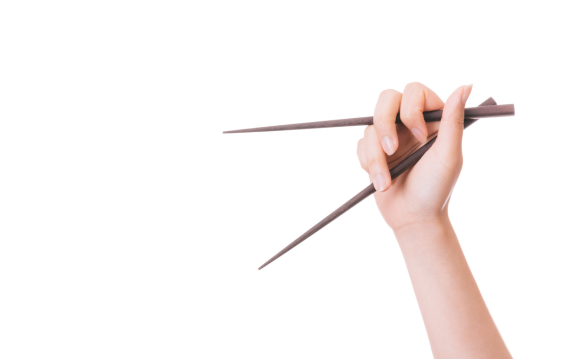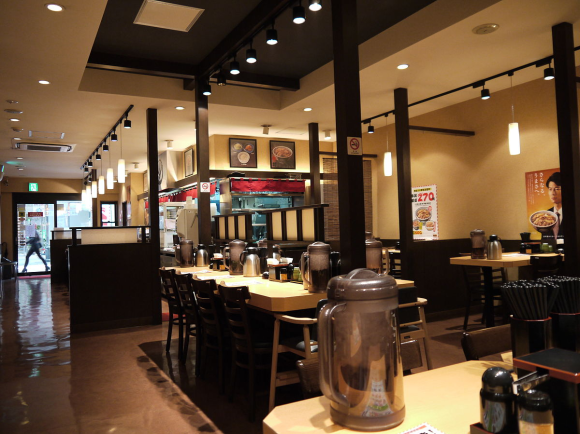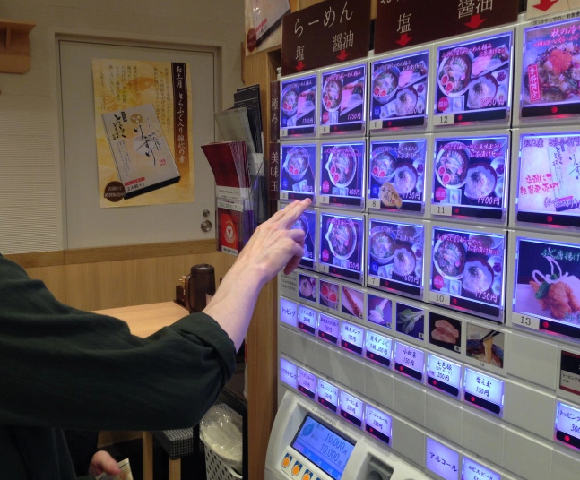
At inexpensive Japanese restaurants, the chopstick container might be in front of another customer, which is a tension-filled dilemma for some.
In a lot of casual restaurants, such as ramen or beef bowl joints, almost all the seating is at a counter. There might be a table or two stuck in the corner, but the vast majority of customers will take a seat along the counter, and it’s pretty much where all single diners are expected to sit.
The reason why is simple: counters take up less space, and having strangers sit next to each other means that there are no wasted, empty seats. For further efficiency, restaurants usually leave a few container full of chopsticks on the counter, along with pitchers of water and condiments, so that customers can grab whatever they need.
▼ Interior of a branch of Yoshinoya, Japan’s most popular beef bowl chain
But as you can see in the photo above, there isn’t a chopstick station set up in front of each and every seat. If there’s not one in front of you, you’re supposed to reach over and grab a pair from the closest container, but for a subset of Japanese diners, this is easier said than done, because they feel anxious or awkward about reaching in front of another diner who’s a complete stranger.
As an extreme example, a user of Japanese Internet forum 2channel recently posted that he went into a beef bowl restaurant, placed his order, and then, once his meal came, noticed that the chopstick container was in front of the person sitting next to him. “I’ve been sitting here for 15 minutes,” he wrote, unable to bring himself to procure a set of eating utensils. “My food’s cold now…”
A number of other commenters chimed in to say they feel similar disease in such a situation. “I totally know what you mean. I get nervous enough talking to the restaurant staff,” said one. Another added “I’m OK getting chopsticks, because you have to have those to eat, but I always hesitate to take the condiments if they’re not right in front of me.”
Something that likely exacerbates the anxiety is that at many casual Japanese restaurants, ordering is done by purchasing a meal ticket from a vending machine at the entrance. You then hand the ticket to the waiter or cook, with no need for any verbal, and only the bare minimum interpersonal, interaction. Diners who’re painfully shy are likely to gravitate to such establishments, and for them the hurdle of entering another customer’s line of sight no doubt feels especially high.
It should be noted, though, that most Japanese people don’t have any problem grabbing what they need. “It’s a lot bigger nuisance to just sit there without eating and weirding everyone out,” remarked one commenter.
In any case, know that the unwritten but commonly followed etiquette is simply to say “sumimasen” or “shitsurei shimasu” (both of which translate as “excuse me”) as you reach for the chopsticks or whatever else you need from that common-use section of the counter, and if anyone gets upset at you for it, Japanese society considers him to be the rude one. And should you happen to notice the person next to you sitting there idly and staring at the chopstick container in front of you, you can always throw him a bone by gesturing towards the utensils and saying “dozo” (“please, go ahead”) to make extra sure he knows you don’t mind his reach.
Source: Livedoor News via Jin
Top image: Pakutaso
Insert images: Wikipedia/DigitalShop78, SoraNews24
Follow Casey on Twitter, and he promises to hook you up with a pair of chopsticks if you’re ever in the same ramen restaurant together.



 Seven facts about Japanese chopsticks to help you win friends and influence people
Seven facts about Japanese chopsticks to help you win friends and influence people “Prisoner of Short Ribs”: Yoshinoya’s first sister restaurant in 10 years (maybe 8?)【Taste test】
“Prisoner of Short Ribs”: Yoshinoya’s first sister restaurant in 10 years (maybe 8?)【Taste test】 You can rest your chopsticks on a lot of different things in Japan
You can rest your chopsticks on a lot of different things in Japan This Tokyo ramen restaurant is the first to ever receive a Michelin dining guide star
This Tokyo ramen restaurant is the first to ever receive a Michelin dining guide star Japan’s first-ever wanko soba conveyor belt restaurant opens in Tokyo
Japan’s first-ever wanko soba conveyor belt restaurant opens in Tokyo Demon Slayer: Kimetsu no Yaiba gets new roller coaster attractions and food at Universal Studios Japan
Demon Slayer: Kimetsu no Yaiba gets new roller coaster attractions and food at Universal Studios Japan Japan’s new difficult-to-drink-from beer glass protects your liver, but it’s a brutal experience
Japan’s new difficult-to-drink-from beer glass protects your liver, but it’s a brutal experience New Nintendo Lego kit is a beautiful piece of moving pixel art of Mario and Yoshi【Photos】
New Nintendo Lego kit is a beautiful piece of moving pixel art of Mario and Yoshi【Photos】 How to order snacks on a Shinkansen bullet train in Japan
How to order snacks on a Shinkansen bullet train in Japan New samurai glasses are Japan’s latest weird must-have souvenir
New samurai glasses are Japan’s latest weird must-have souvenir Come play hide-and-seek on a deserted Japanese island this August and November
Come play hide-and-seek on a deserted Japanese island this August and November New Pokémon ice cream, dessert drinks, and cool merch coming to Baskin-Robbins Japan【Pics】
New Pokémon ice cream, dessert drinks, and cool merch coming to Baskin-Robbins Japan【Pics】 Caffeinated ramen for gamers that you can eat with one hand going on sale in Japan
Caffeinated ramen for gamers that you can eat with one hand going on sale in Japan Starbucks Japan unveils New Year’s collection for 2024, with daruma, dragons and Mt Fuji for luck
Starbucks Japan unveils New Year’s collection for 2024, with daruma, dragons and Mt Fuji for luck Real Buddhist monk plays Super Mario Bros., recites prayers every time he kills an enemy【Video】
Real Buddhist monk plays Super Mario Bros., recites prayers every time he kills an enemy【Video】 Nintendo history you can feel – Super NES, N64, and GameCube controllers become capsule toys
Nintendo history you can feel – Super NES, N64, and GameCube controllers become capsule toys Hello, cosmetics! Clinique teams up with Hello Kitty this summer for first-time collaboration
Hello, cosmetics! Clinique teams up with Hello Kitty this summer for first-time collaboration “The most Delicious Cup Noodle in history” – Japan’s French Cup Noodle wins our heart【Taste test】
“The most Delicious Cup Noodle in history” – Japan’s French Cup Noodle wins our heart【Taste test】 Starbucks releases a cute Frappuccino and Unicorn Cake…but not in Japan
Starbucks releases a cute Frappuccino and Unicorn Cake…but not in Japan Kyoto Tower mascot termination reveals dark side behind cute Japanese characters
Kyoto Tower mascot termination reveals dark side behind cute Japanese characters McDonald’s Japan’s Soft Twist Tower: A phantom ice cream only sold at select branches
McDonald’s Japan’s Soft Twist Tower: A phantom ice cream only sold at select branches Yabai Ramen: What makes this Japanese ramen so dangerous?
Yabai Ramen: What makes this Japanese ramen so dangerous? Finally! Nintendo Japan expands Switch 8-bit controller sales to everybody, Online member or not
Finally! Nintendo Japan expands Switch 8-bit controller sales to everybody, Online member or not Japanese government wants to build luxury resorts in all national parks for foreign tourists
Japanese government wants to build luxury resorts in all national parks for foreign tourists To combat declining birth rate, Japan to begin offering “Breeding Visas” to foreigners
To combat declining birth rate, Japan to begin offering “Breeding Visas” to foreigners 10 things you should buy at 7-Eleven in Japan
10 things you should buy at 7-Eleven in Japan Studio Ghibli releases anime heroine cosplay dresses that are super comfy to wear
Studio Ghibli releases anime heroine cosplay dresses that are super comfy to wear Woman charged for driving suitcase without a license in Osaka
Woman charged for driving suitcase without a license in Osaka Studio Ghibli unveils My Neighbour Totoro miniature house model
Studio Ghibli unveils My Neighbour Totoro miniature house model Kyoto experiencing problems with foreign tourists not paying for bus fares, but not on purpose
Kyoto experiencing problems with foreign tourists not paying for bus fares, but not on purpose Fighting mild hunger with a Japanese soda that turns into jelly in the stomach【Taste test】
Fighting mild hunger with a Japanese soda that turns into jelly in the stomach【Taste test】 Studio Ghibli’s Howl’s Moving Castle tapestry unveiled in Japan for first time
Studio Ghibli’s Howl’s Moving Castle tapestry unveiled in Japan for first time McDonald’s new Happy Meals offer up cute and practical Sanrio lifestyle goods
McDonald’s new Happy Meals offer up cute and practical Sanrio lifestyle goods Sales of Japan’s most convenient train ticket/shopping payment cards suspended indefinitely
Sales of Japan’s most convenient train ticket/shopping payment cards suspended indefinitely Sold-out Studio Ghibli desktop humidifiers are back so Totoro can help you through the dry season
Sold-out Studio Ghibli desktop humidifiers are back so Totoro can help you through the dry season Japanese government to make first change to romanization spelling rules since the 1950s
Japanese government to make first change to romanization spelling rules since the 1950s Foreigner’s request for help in Tokyo makes us sad for the state of society
Foreigner’s request for help in Tokyo makes us sad for the state of society Ghibli founders Toshio Suzuki and Hayao Miyazaki contribute to Japanese whisky Totoro label design
Ghibli founders Toshio Suzuki and Hayao Miyazaki contribute to Japanese whisky Totoro label design Doraemon found buried at sea as scene from 1993 anime becomes real life【Photos】
Doraemon found buried at sea as scene from 1993 anime becomes real life【Photos】 Tokyo’s most famous Starbucks is closed
Tokyo’s most famous Starbucks is closed Princesses, fruits, and blacksmiths: Study reveals the 30 most unusual family names in Japan
Princesses, fruits, and blacksmiths: Study reveals the 30 most unusual family names in Japan Is there any point to holding your chopsticks the “correct” way? Let’s find out【Experiment】
Is there any point to holding your chopsticks the “correct” way? Let’s find out【Experiment】 Ichiran Ramen calendar features moving parts so you can make every day noodle day
Ichiran Ramen calendar features moving parts so you can make every day noodle day Japanese restaurant combines solo shabu shabu dining with the fun of a sushi train
Japanese restaurant combines solo shabu shabu dining with the fun of a sushi train A visit to the back-alley Tokyo ramen restaurant listed in the Michelin dining guide
A visit to the back-alley Tokyo ramen restaurant listed in the Michelin dining guide Ramen vending machine in Tokyo satisfies noodle and gyoza cravings at any time of day or night
Ramen vending machine in Tokyo satisfies noodle and gyoza cravings at any time of day or night Ramen with bread and grilled cheese topping is our favourite noodle trend in Tokyo right now
Ramen with bread and grilled cheese topping is our favourite noodle trend in Tokyo right now The most delicious way to eat tonkatsu blows people’s minds in Japan
The most delicious way to eat tonkatsu blows people’s minds in Japan We test Japan’s new Gaming Chopsticks Holder
We test Japan’s new Gaming Chopsticks Holder 2,500 yen for Tokyo ramen? High-end noodles in the high-rent Ginza district are totally worth it
2,500 yen for Tokyo ramen? High-end noodles in the high-rent Ginza district are totally worth it Japan’s new edible chopsticks have a special flavor, but don’t taste like “food”
Japan’s new edible chopsticks have a special flavor, but don’t taste like “food” Should you say “Itadakimasu,” Japan’s pre-meal expression of thanks, when eating by yourself?
Should you say “Itadakimasu,” Japan’s pre-meal expression of thanks, when eating by yourself? Yoshinoya has an ultra-luxurious wagyu beef bowl you can only get one place in Japan【Taste test】
Yoshinoya has an ultra-luxurious wagyu beef bowl you can only get one place in Japan【Taste test】 Sukiya beef bowl chain makes Japanese New Year fun with limited-edition fukubukuro
Sukiya beef bowl chain makes Japanese New Year fun with limited-edition fukubukuro Is it OK to put other food on top of your white rice when eating in Japan?
Is it OK to put other food on top of your white rice when eating in Japan? Tokyo restaurant offers amazing sushi lunch deal for less than 5 bucks
Tokyo restaurant offers amazing sushi lunch deal for less than 5 bucks
Leave a Reply